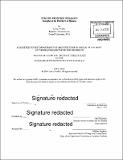| dc.contributor.advisor | Miho Mazereeuw. | en_US |
| dc.contributor.author | Ovalles, Larisa | en_US |
| dc.contributor.other | Massachusetts Institute of Technology. Department of Architecture. | en_US |
| dc.coverage.spatial | s-bl--- | en_US |
| dc.date.accessioned | 2017-01-12T18:32:40Z | |
| dc.date.available | 2017-01-12T18:32:40Z | |
| dc.date.copyright | 2016 | en_US |
| dc.date.issued | 2016 | en_US |
| dc.identifier.uri | http://hdl.handle.net/1721.1/106419 | |
| dc.description | Thesis: S.M., Massachusetts Institute of Technology, Department of Architecture, 2016. | en_US |
| dc.description | Page 242 blank. Cataloged from PDF version of thesis. | en_US |
| dc.description | Includes bibliographical references (pages 212-216). | en_US |
| dc.description.abstract | The Amazonia basin has been the protagonist of many large scale infrastructural and colonization ambitions that are closely tied to larger global economic pressures. These are mainly manifest along the peripheries and edges where both deforestation and land conflict have intensified alongside rapid rates of urbanization. Increased environmental awareness and the use of nature as capital make obvious that Nature can no longer be disregarded. This sets up a scenario where the Frontier has the potential for coupling and hybridization towards a new common project, one where built space and natural space are no longer mutually exclusive, but instead work within a systematic relationship that can adapt to land use transformations through time. The Amazonian frontier is not a border or a purely linear development between settled and unsettled territory in the Turnerian sense, but a field of heterogeneity: where the interplay of actors and their interests produces a space where a series of articulated scales of temporalities and spatialities coexist. This thesis investigates the territorial implications of urbanization patterns along the Amazonian frontier as a potential space for experimentation and creation of new hybrid zones. In order to establish a new hybrid periphery growth model at the frontier which incorporates natural and built space, the project explores ecological, agrarian, and urban tools and proposes strategies of addition and subtraction, sharing and exchange in order to: connect and link disarticulated forest fragments; contain and guide development; and provide alternative hybrid and collective models for new Productive Landscapes. In doing so, the project examines the dynamics and interplay between two entities, nature and development, in order to create strategies for a collective zone that capitalizes on the dynamic quality of the Amazonian frontier. | en_US |
| dc.description.statementofresponsibility | by Larisa Ovalles. | en_US |
| dc.format.extent | 242 pages | en_US |
| dc.language.iso | eng | en_US |
| dc.publisher | Massachusetts Institute of Technology | en_US |
| dc.rights | M.I.T. theses are protected by copyright. They may be viewed from this source for any purpose, but reproduction or distribution in any format is prohibited without written permission. See provided URL for inquiries about permission. | en_US |
| dc.rights.uri | http://dspace.mit.edu/handle/1721.1/7582 | en_US |
| dc.subject | Architecture. | en_US |
| dc.title | Staging frontier dynamics : interplay at the periphery of Manaus | en_US |
| dc.type | Thesis | en_US |
| dc.description.degree | S.M. | en_US |
| dc.contributor.department | Massachusetts Institute of Technology. Department of Architecture | |
| dc.identifier.oclc | 967223895 | en_US |
